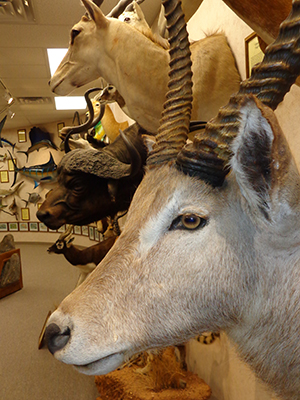AC’s Natural History Museum Teeming with Exotic Specimens
 If you would like to see a Brazilian beetle that’s just a mite larger than a Texas tarantula, a bug whose suitably redundant name slithers off the tongue at a snail’s pace, then make a beeline to AC’s Natural History Museum.
If you would like to see a Brazilian beetle that’s just a mite larger than a Texas tarantula, a bug whose suitably redundant name slithers off the tongue at a snail’s pace, then make a beeline to AC’s Natural History Museum.
The Titanus giganteus awaits your perusal.
Cocooned within the northernmost environs of Ordway Hall’s first floor, the museum on the Washington Street Campus is home to a veritable swarm of globally collected insects—colossal species, some—mounted, maintained, and presented by the Biology Department for scholarly pursuits and public edification.
Of course you’ll find far more than meticulously displayed arthropods at the Natural History Museum. Taxidermic mammals, big-game fish, and birds (some of prey) loom from mounts and perches throughout. There’s a sprinkling of other collections, too—skulls, pelts, age-old eggs—one solely for handling by the blind.
For every visitor wowed by the near-neon vibrancy of the bounteous butterflies, another is enchanted by a rare, up-close encounter with a bald eagle, a hammerhead shark, or a Cape buffalo out of Africa.
“People are amazed by the specimens we have here,” Tiffany Lamb, associate professor of biology and museum director, said. “We have a lot of insects, big creepy ones that you’re not going to see unless you’re deep in the jungles of Indonesia or South America.
“We have wonderful animals, many from other continents, some that are now threatened or endangered so that they can’t be collected anymore. People really get excited about them.”
AC owes its Natural History Museum to Richard Howard, a longtime member of the biology faculty who stepped away from the College a few years ago to brave the challenges of Parkinson’s disease. Something of a Renaissance man, Howard is that consummate entomologist and curator who somehow found time to simultaneously, teach biology and taxidermy, coach fencing, and compose, perform and record classical piano music.
His extensive collecting expeditions have taken him the world over, and his enviable stockpile of insects, particularly the butterflies, became the basis in the mid-1970s for a museum at AC. And like a butterfly, it flitted around some.
Originally the collection was displayed on the second floor of what is now Dutton Hall. Then it spent some years in Durrett Hall. It landed at its present location in the late 1990s, by which time Howard had a right hand in Dan Porter, professor of biology, who accepted an invitation at mid-decade to become associate curator and collections manager.
Porter, whose devoted service to the museum spanned 17 years, doggedly pursued grants. He obtained many that either helped grow the collections or expand the museum’s services. Safari Club International, for example, donated not only the African mammal collection, but contributed funds for the expansion necessary to house it.
From 2000 to 2012, Porter personally delivered innumerable natural history programs at area schools. He acquired. He catalogued. He conducted countless tours of the museum for folks of all ages, but especially for kids.
“You never really know what will light a fire under kids,” Porter said. “I believe the more we expose them to the marvels of science, wonders like the eight-inch Goliath butterfly or one of the largest beetles in the world, the better our chances are of sparking an interest in learning.
“We are one of the only community colleges anywhere with a museum of this kind, certainly of this quality, and we’re lucky to have it,” he said. “It’s a definite fire-starter for knowledge and education.”
The museum’s torch was passed to Lamb in 2013, and she says it continues to be a popular destination for classes from area schools, tourists of all sorts, and visiting researchers. Many AC students find their way to the museum, too. Science classes are commonly exposed to the unique AC resource, but students of art and English also are known to undertake class projects based on what they discover within. Lamb says she hopes to see the facility incorporated even more into AC curricula.
“The museum is a good bridge between disciplines,” she said. “There are so many research possibilities available, and whenever we take a group of students over there, they say ‘wow, I didn’t know this was here.’ We want everyone to know it is here and to reap its benefits.”
In that vein, visitors are always welcome. The museum is open some hours most days. A link at actx.edu/biology states when. Tours can be arranged. Just call the Biology Department to clear the way—371-5081.
It’s truly worth lumbering over to Ordway Hall if only to witness the wooden mimicry of the giant Malaysian walking stick. Talk about a fire-starter.
August 19, 2015